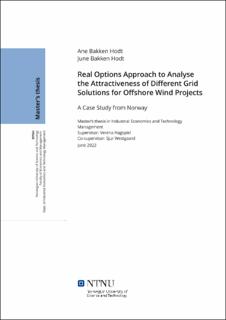| dc.description.abstract | På veien mot klimanøytralitet og etablering av ny grønn industri i Norge, har den norske regjeringen nylig avslørt planer for hvordan en storskala utbygging av havvind på norsk kontinentalsokkel skal realiseres. Formålet med denne artikkelen er å analysere den økonomiske attraktiviteten for tre nettløsninger til havs for havvindprosjekter: en radial forbindelse og et hybridnett mellom to og tre kraftmarkeder. Disse studeres under ulike markedsforhold fra et havvindutbyggers perspektiv. Vi foretar en realopsjonsanalyse gjennom å benytte en least squares Monte Carlo-algoritme for å ta hensyn til usikkerhet i elektrisitetspriser og beslutingstakerens fleksibilitet. To støtteordninger for hybridprosjekter er undersøkt: reallokering av en andel flaskehalsinntekter samt økonomisk kompensasjon på grunn av utilgjengelig transmisjonskapasitet til fastlandet (TAG). I tillegg studerer vi hvordan regulatorisk usikkerhet med tanke på uforutsigbarhet i fremtidige nettløsninger påvirker utbyggernes investeringsincentiver. Vi presenterer en casestudie av et havvindprosjekt i Sørlige Nordsjø II i Nordsjøen der vi ser på en radial tilknytning til Norge, et bilateralt hybridprosjekt mellom Norge og Storbritannia, og et trilateralt hybridprosjekt mellom Norge, Storbritannia og Danmark. Våre funn viser at en kobling mellom tre markeder er mest attraktivt for utbyggere dersom hjemmemarkedet generelt har de laveste prisene. Vi finner at økt prisvolatilitet gjør utbyggere i spesielt et bilateralt hybridprosjekt utsatt for tapsrisiko. Investering i et trilateralt hybridprosjekt kan gi bedre beskyttelse under slike markedsforhold. Reallokering av flaskehalsinntekter kan reversere den uheldige effekten av store prisvariasjoner og skape større investeringsincentiver for hybridprosjekter. Ved store prisvarisjoner under kapasitetsbegrensninger kan TAG være mer attraktivt enn flaskehalsinntekter. Dog er ikke TAG alene tilstrekkelig for å utlikne prisrisiko i en offshore budsone. Videre viser vi at å tillate trilaterale hybridprosjekter fra begynnelsen av er mer økonomisk gunstig enn å forsinke dette alternativet ved å først etablere radiale prosjekter. Våre resultater indikerer at usikkerhet fra myndighetenes side har en betydelig påvirkning på utbyggernes investeringsincentiver. Vi viser at dersom utbyggerne ikke har tilstrekkelig tillit til regjeringen om at radiale forbindelser vil bli utvidet til et trilateralt nett til rett tid, vil investeringsincentiver reduseres. Våre funn støtter derfor at regjeringen bør strebe etter å skape klarhet rundt nettløsningene for å forsikre en effektiv utbygging av havvindprosjekter. | |
| dc.description.abstract | As a step towards climate neutrality and the establishment of a new green industry in Norway, the Norwegian government has recently revealed plans to make large-scale offshore wind development on the Norwegian continental shelf a reality. From the perspective of an offshore wind developer, this paper aims to analyse the economic attractiveness of three offshore grid solutions for offshore wind projects: a radial connection and hybrid grids between two and three power markets, under different market conditions. We apply a real options approach implemented through a least squares Monte Carlo algorithm to account for uncertainty in electricity prices and managerial flexibility. Two support schemes for hybrid projects are examined: reallocation of a share of congestion income and a Transmission Access Guarantee (TAG). In addition, the impact of regulatory uncertainty in terms of unpredictable future grid solutions on developers' investment incentives is studied. We present a case study of an offshore wind project at Sørlige Nordsjø II in the North Sea considering a radial connection to Norway, a bilateral hybrid grid between Norway and the UK, and a trilateral hybrid grid between Norway, the UK and Denmark. Our findings suggest that for generally low home market prices, connecting three markets is most attractive to developers. We find that increased price fluctuations increase the developer's exposure to downside risk specifically under a bilateral hybrid setup, and that investing in a trilateral hybrid grid can give better protection under such market conditions. Reallocating congestion income can reverse the adverse impact of high price volatility and create larger investment incentives for hybrid projects. Under capacity limitations, the TAG can be more attractive than congestion income for high price volatility, however, the TAG alone is not sufficient to offset price risk in an offshore bidding zone. Further, we show that allowing for a trilateral hybrid solution from the beginning on is more economically beneficial than delaying this alternative on account of a first establishment of a radial project. Our results indicate that regulatory uncertainty has a significant impact on developers' investment incentives. We show that if developers do not have sufficient trust in that radial connections will be extended to a trilateral grid in time, investment incentives decrease. Our findings therefore support that the government should aim to create clarity on grid solutions in order to ensure an efficient build-out of offshore wind projects. | |
